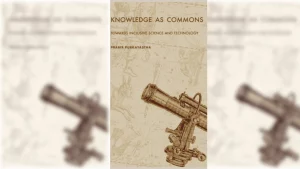This is an excerpt from The Historian and her Craft: Collected Essays and Lectures of Romila Thapar, recently published by the Oxford University Press and republished here with the author’s permission. It is the third among our series focusing on Romila Thapar’s collected works; read the first here, and the second here.

Aryan domination, irrespective of form or agency, has been the basic theme of the history of the first millennium bc in India. This was said to be the result of either an invasion or a migration into India of people belonging to the Aryan race in such overwhelming numbers that it resulted in a displacement of pre-existing populations and their primitive cultures. The latter were said to have fled to the south of the subcontinent, where they gave rise to what was called the Dravidian race and Dravidian culture. The massive invasion was said to be of a superior race of Aryans who subjugated the autochthons, reduced them to slavery and introduced civilization.
This view was useful to colonial interpretations of Indian history since parallels were drawn between the Aryan conquest and the British conquest. It also appealed to some members of the upper castes who saw themselves as the lineal, biological descendants of the racially superior Aryans. Nationalist historiography by and large accepted the theory of invasion. Some who were not historians preferred to think of the Aryans as indigenous in order to claim Indian origins for what was regarded as a superior civilization. As an interesting reversal, it also became a major argument in the claim of lower castes who maintained that the brāhmaṇas were alien invaders and oppressors and had usurped the rights to the land of the indigenous lower castes, dalits and tribals.1 This view sought support from the discovery of the Indus Civilization as the pre-Aryan civilization of the indigenous peoples. The Aryan theory therefore has been central to many of the political contestations over identity and status during the evolution of the Indian nation-state in the last two centuries. As a contrast to this, although Aryanism is assumed in some pre-colonial sources, it is rarely defined or analysed in detail.
The theory of an invasion has now been questioned. It was originally based on references in the Ṛgveda to hostilities between the āryas and the dāsas , taken as representations of the victorious Aryans overcoming the local Dāsas. The archaeological picture of the second and first millennia bc (or even earlier for that matter) provides little or no support for a largescale invasion, or a displacement of peoples and cultures. There is evidence of what must have been small-scale confrontations, such as at the site of Kot Diji, but these do not amount to an invasion.
However, the pendulum has swung to the other extreme among some archaeologists and historians and it is now being said that not only were the Aryans indigenous but that they were also the authors of the Indus Civilization (renamed by them as the Indus-Sarasvatī civilization) and that the Ṛgveda as the earliest composition of the Aryans should be identified with the Harappa culture of the third millennium bc or even the pre-Harappan culture of the fourth millennium. 2 In spite of the constant repetition of this view in an attempt to enforce it, it fails the test, since the evidence—both archaeological and literary—does not support it.3 This is a different argument from that which suggests that there could have been some continuities from Harappan times into the later period and that the Vedic culture as a post-Harappan culture may reflect some of these. The notion that the Vedic culture and language had a genesis only within the Indian subcontinent goes back to the politically-motivated Hindutva literature of the 1920s and 1930s. The intention was to insist that the Hindus alone, as lineal descendants of the Aryans, were indigenous, whereas the Muslims and Christians were alien. The Dalit insistence that the Aryan invasion resulted in caste confrontation, as had been proposed by Jyotiba Phule, was replaced in the Hindutva view by identifying differences on the basis of religion. Needless to say it makes little historical sense to speak of identities as indigenous or alien for a period three thousand years ago, when there were no cartographic boundaries or national territories and there were immense intermixtures of people.
In any comparison of the Harappan and Rigvedic cultures it is necessary to consider their parameters and their systemic patterns, and not limit the discussion to what might be a few items familiar to each. The Harappa Culture cannot be identified with the Rigvedic as they are neither contemporary nor are their characteristics identical. The geographical area included in the Harappan system was far more extensive than the region known to the Ṛgveda.
The Indus Civilization had an extensive agrarian base and an urban population dependent on food production in rural areas. Huge storage structures have been identified, possibly as granaries or as warehouses. Not only was it essentially urban but the construction of structures in the élite sections of the cities involved massive brick platforms which, apart from extensive brick-making, would have required elaborate arrangements for obtaining and controlling labour. This points to an entirely different social organization from that characteristic of the Ṛgveda. The demarcation between the citadel area of the élite and the residential area was emphasized by a physical separation, and the latter consisted of large familial houses with well-developed civic amenities. The layout of the cities and the meticulously constructed drainage system are pointers to a sophisticated urbanism. This suggests a system more advanced than that of clan chiefs.
The economy of the cities was based on the gathering of resources and the production of items for trade such as beads and copper ingots, among others. The technology of copper-bronze was not spectacular but focused on a range of items. Obtaining raw materials and organizing craft production would have required a substantial category of supervisors and managers. A script, still undeciphered, was widely employed and was functional in origin. For instance, one of the uses of the seals on which it occurs was for stamping packages of goods. Little is known of the Harappan religion and the possibility of fertility cults and mother-goddess worship has been postulated. The animals most frequently depicted on the seals are the ‘unicorn’—perhaps a version of the rhinoceros, the bull, the elephant and occasionally the tiger.4 The horse is conspicuously absent until the early second millennium bc when it turns up sporadically in various parts of west Asia as well. Associated with the horse was the chariot and the spoked wheel, both as innovations.
The gradual decay of the cities, generally attributed to environmental factors and decline in trade, did not result in the termination of the culture. There is evidence of the usual characteristics of declining urban centres—squatters and rural migrants moving in, and a dispersal of the city population. There were contacts not only with subsequent cultures such as the Painted Grey Ware in some sites of the Punjab, but possibly also with contemporary Black-and-Red Ware sites in Gujarat. It is feasible to suggest that some of the Harappan traditions in the form of mythology and rituals may well have continued. Nevertheless, the decline of the cities would have resulted in a discontinuance of the Harappan administrative system and in the rural areas people would have been unprotected and subject to new forms of dominance by local authorities. It may legitimately be asked if there was now a search for new protectors.
The Ṛgveda describes a non-urban, chalcolithic, agro-pastoral society with cattle keeping as its central concern. The geographical spread of the Ṛgveda is only a part of the much larger area involved in the Indus civilization. Areas crucial to the Harappan trade such as Gujarat, Sind, Oman, the Persian Gulf and Mesopotamia are unknown to the Ṛgveda , whose geography is defined by the use of the term sapta sindhu and the rivers listed in the nadī-stuti hymn (10.75),5 essentially eastern Afghanistan and the undivided Punjab upto the watershed. The geography of the Vedic corpus subsequent to the Ṛgveda and incorporating the Ganga valley is of course outside the experience of the Indus civilization.
There is little in the Ṛgveda about craft production, the main concern being with cattle-raids and the produce of cattle herds. The metal technology of the Ṛgveda is copper-bronze, the metal being referred to as ayas (6.3.5; 47.10). There might have been some veering towards iron since the meaning of the generic word ayas could refer to iron, even if the latter is generally described in the post-Rigvedic corpus as the dark metal— kṛṣṇa ayas. A writing system has no function in this culture. The rhino, elephant and tiger are unfamiliar animals. The horse however is central to socioeconomic functioning—in herding, raiding and transportation—and to ritual as the focus of a major sacrifi ce—which was to evolve into the aśvamedha. The authors of the Ṛgveda are critical of the rites pertaining to fertility cults and references to goddesses are few and far between. The Rigvedic religion is dominated by male deities among whom the virile hero Indra is pre-eminent.
This brief summary should clarify the essentially diff erent type of societies that emerge from the evidence of the Harappa Culture and the Ṛgveda , even if there be some similarity in a few items. To argue therefore that the Ṛgveda should be identifi ed with the Harappa Culture points to a lack in understanding the essentials of the comparative method in historical analysis.
* Originally published as ‘The Rgveda: Encapsulating Social Change’ in K.N.Panikkar, Terence J. Byers and Utsa Patnaik, eds, The Making of History: Essays Presented to Irfan Habib (New Delhi: Tulika Books, third edition, 2011 {2000]),pp.11-40. Used with permission. I would like to thank Dr K.Meenakshi, Professor F. Staal, and Dr Kumkum Roy for their comments on this paper and in general on the thoughts expressed here. These comments have helped me to clarify some of my ideas.
1. R. Thapar,’The theory of Aryan Race and India: History and Politics’, Social Scientist,24, 1-3,1996,pp.3-29.
2. E.g.,S.P. Gupta.’Longer Chronolgy of the Indus Civilisation’, Puratattva,23,1992-93,pp.21-29;and S.P.Gupta (ed.), The Lost Sarasvati and the Indus Civilisation (Jodhpur: Kusumanjali Publications, 1995) B.B.Lal had earlier identified the Aryans with the Painted Grey Ware culture and built his interpretation of archeology and the epics on this. He now argues for the identity of the Harappan and Vedic cultures: B.B. Lal, ‘The Indo-Aryan Hypothesis vis-a-vis Indian Archaeology’, Jornal of Central Asia,1,1, 1978, pp 21ff.; B.B.Lal, The Earliest Civilisation of South Asia (New Delhi: Aryan Books International, 1997), pp.281-7.
3. A number of studies of this period reject this view and among them are R.S. Sharma, Advent of the Aryans in India (Delhi: Manohar, 1990) and A. Parpola, The Roots of Hinduism (New York: Oxford University Press, 2015).
4. The tiger and the rhinoceros are reported from Sind and Punjab as late as in medival sources.
5. Figures in brackets refer to the mandala, the hymn and the verse, in the Rgveda. Where words are quoted from the text, the orignal grammatical form has been retained.



